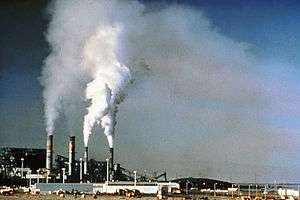Flue-gas emissions from fossil-fuel combustion

Flue-gas emissions from fossil-fuel combustion refers to the combustion-product gas resulting from the burning of fossil fuels.[1] Most fossil fuels are combusted with ambient air (as differentiated from combustion with pure oxygen). Since ambient air contains about 79 volume percent gaseous nitrogen (N2),[2] which is essentially non-combustible, the largest part of the flue gas from most fossil-fuel combustion is uncombusted nitrogen. Carbon dioxide (CO2), the next largest part of flue gas, can be as much as 10−25 volume percent or more of the flue gas. This is closely followed in volume by water vapor (H2O) created by the combustion of the hydrogen in the fuel with atmospheric oxygen. Much of the 'smoke' seen pouring from flue gas stacks is this water vapor forming a cloud as it contacts cool air.
A typical flue gas from the combustion of fossil fuels contains very small amounts of nitrogen oxides (NOx), sulfur dioxide (SO2) and particulate matter.[1] The nitrogen oxides are derived from the nitrogen in the ambient air as well as from any nitrogen-containing compounds in the fossil fuel. The sulfur dioxide is derived from any sulfur-containing compounds in the fuels. The particulate matter is composed of very small particles of solid materials and very small liquid droplets which give flue gases their smoky appearance.
The steam generators in large power plants and the process furnaces in large refineries, petrochemical and chemical plants, and incinerators burn considerable amounts of fossil fuels and therefore emit large amounts of flue gas to the ambient atmosphere. The table below presents the total amounts of flue gas typically generated by the burning of fossil fuels such as natural gas, fuel oil and coal. The data were obtained by stoichiometric[3] calculations.[4]
It is of interest to note that the total amount of flue gas generated by coal combustion is only 10 percent higher than the flue gas generated by natural-gas combustion.
| Combustion data | Fuel gas | Fuel oil | Coal |
|---|---|---|---|
| Fuel properties: | |||
| Gross caloric value, MJ/m³ | 43.01 | ||
| Gross heating value, Btu/scf | 1,093 | ||
| Gross caloric value, MJ/kg | 43.50 | ||
| Gross heating value, Btu/gal | 150,000 | ||
| Gross caloric value, MJ/kg | 25.92 | ||
| Gross heating value, Btu/lb | 11,150 | ||
| Molecular weight | 18 | ||
| Specific gravity | 0.9626 | ||
| Gravity, °API | 15.5 | ||
| Carbon/hydrogen ratio by weight | 8.1 | ||
| weight % carbon | 61.2 | ||
| weight % hydrogen | 4.3 | ||
| weight % oxygen | 7.4 | ||
| weight % sulfur | 3.9 | ||
| weight % nitrogen | 1.2 | ||
| weight % ash | 12.0 | ||
| weight % moisture | 10.0 | ||
| Combustion air: | |||
| Excess combustion air, % | 12 | 15 | 20 |
| Wet exhaust flue gas: | |||
| Amount of wet exhaust gas, m³/GJ of fuel | 294.8 | 303.1 | 323.1 |
| Amount of wet exhaust gas, scf/106 Btu of fuel | 11,600 | 11,930 | 12,714 |
| CO2 in wet exhaust gas, volume % | 8.8 | 12.4 | 13.7 |
| O2 in wet exhaust gas, volume % | 2.0 | 2.6 | 3.4 |
| Molecular weight of wet exhaust gas | 27.7 | 29.0 | 29.5 |
| Dry exhaust flue gas: | |||
| Amount of dry exhaust gas, m³/GJ of fuel | 241.6 | 269.3 | 293.6 |
| Amount of dry exhaust gas, scf/106 Btu of fuel | 9,510 | 10,600 | 11,554 |
| CO2 in dry exhaust gas, volume % | 10.8 | 14.0 | 15.0 |
| O2 in dry exhaust gas, volume % | 2.5 | 2.9 | 3.7 |
| Molecular weight of dry exhaust gas | 29.9 | 30.4 | 30.7 |
- Note: m³ are standard cubic meters at 0 °C and 101.325 kPa, and scf is standard cubic feet at 60 °F and 14.696 psia.
See also
- AP 42 Compilation of Air Pollutant Emission Factors
- Emission standard
- Flue-gas stack
- Flue gas
- Flue-gas desulfurization
- Gas stoichiometry
- Stoichiometry
References
- 1 2 Compilation of Air Pollutant Emission Factors
- ↑ Perry, R.H. and Green, D.W. (Editors) (1997). Perry's Chemical Engineers' Handbook (7th ed.). McGraw Hill. ISBN ISBN 0-07-049841-5.
- ↑ Zumdahl, Steven S. (2005). Chemical Principles (5th ed.). Houghton Mifflin College Division. ISBN 0-618-37206-7.
- ↑ Air Dispersion Modeling Conversions and Formulas
External links
- Article on Flue Gas Treatment including desulfurization and the removal of hydrogen chloride, sulphur trioxide, and mercury.